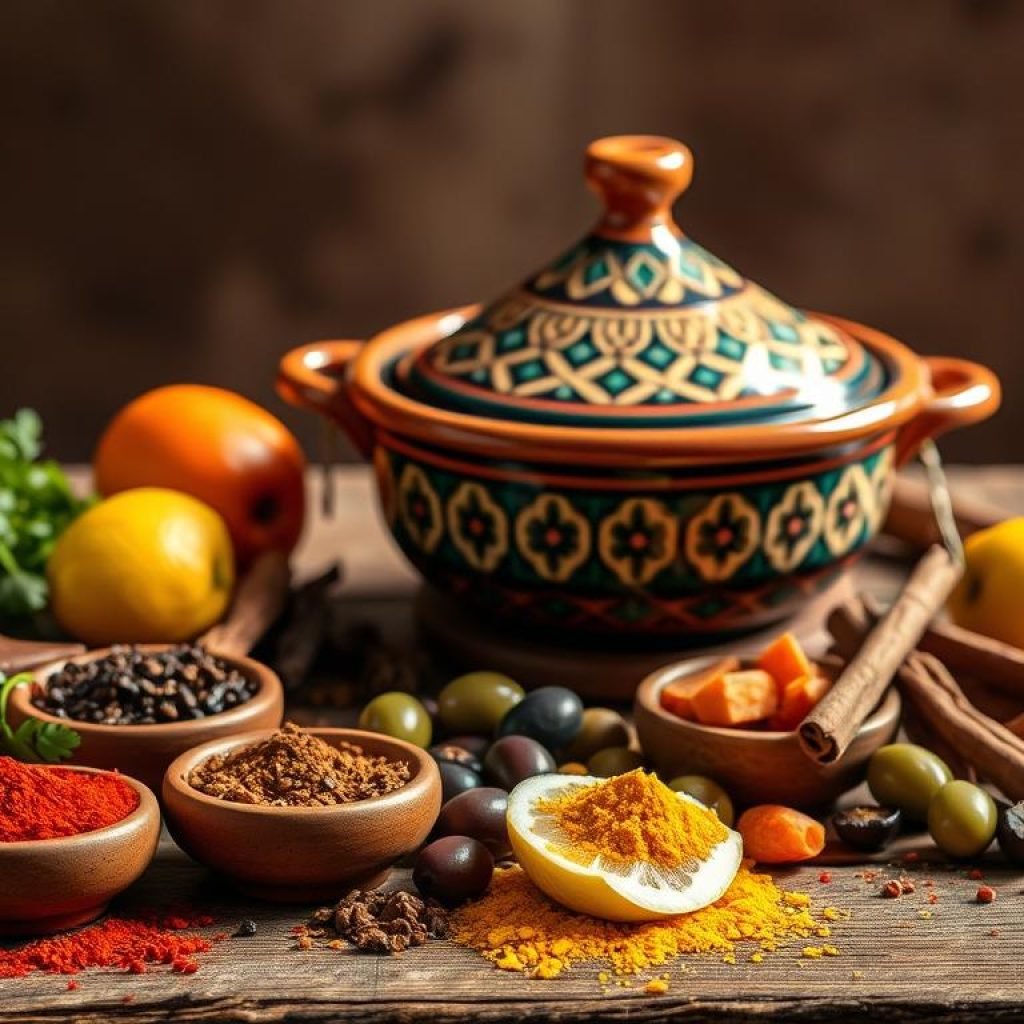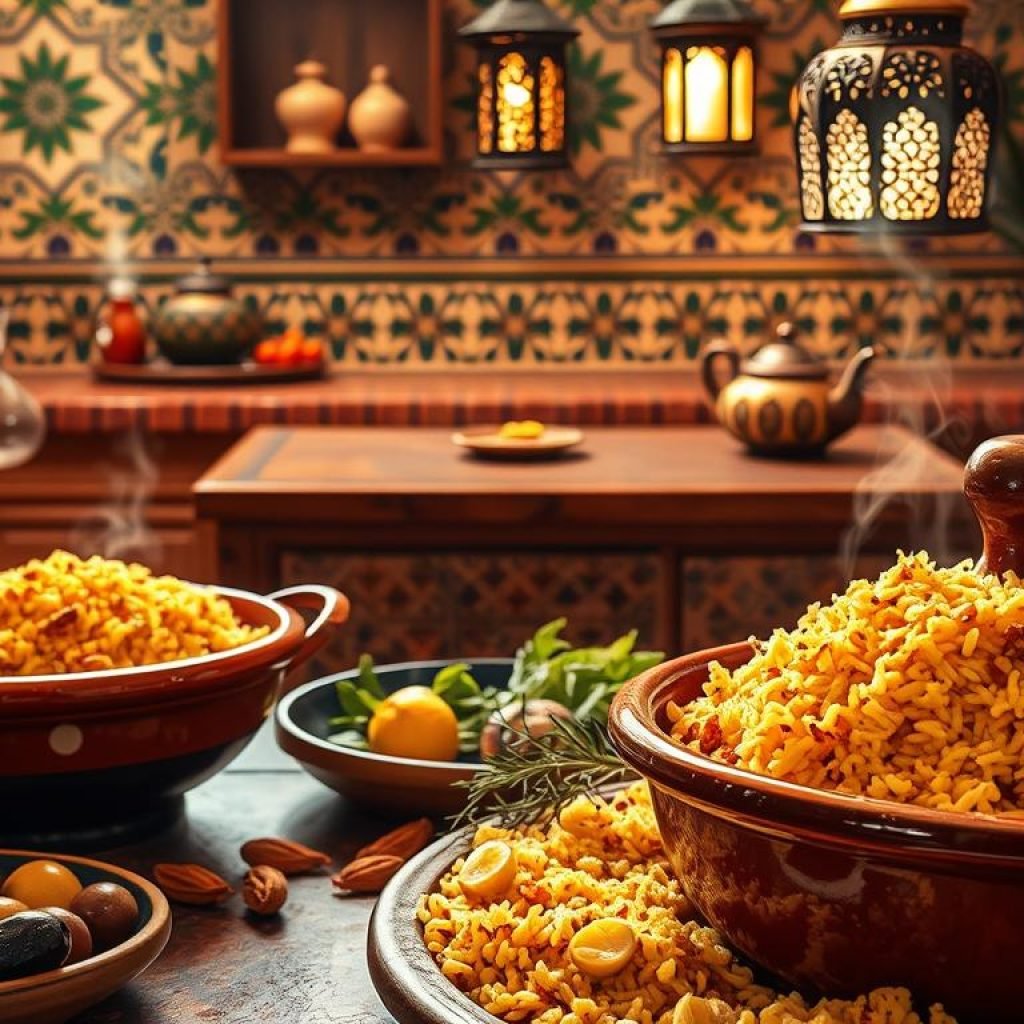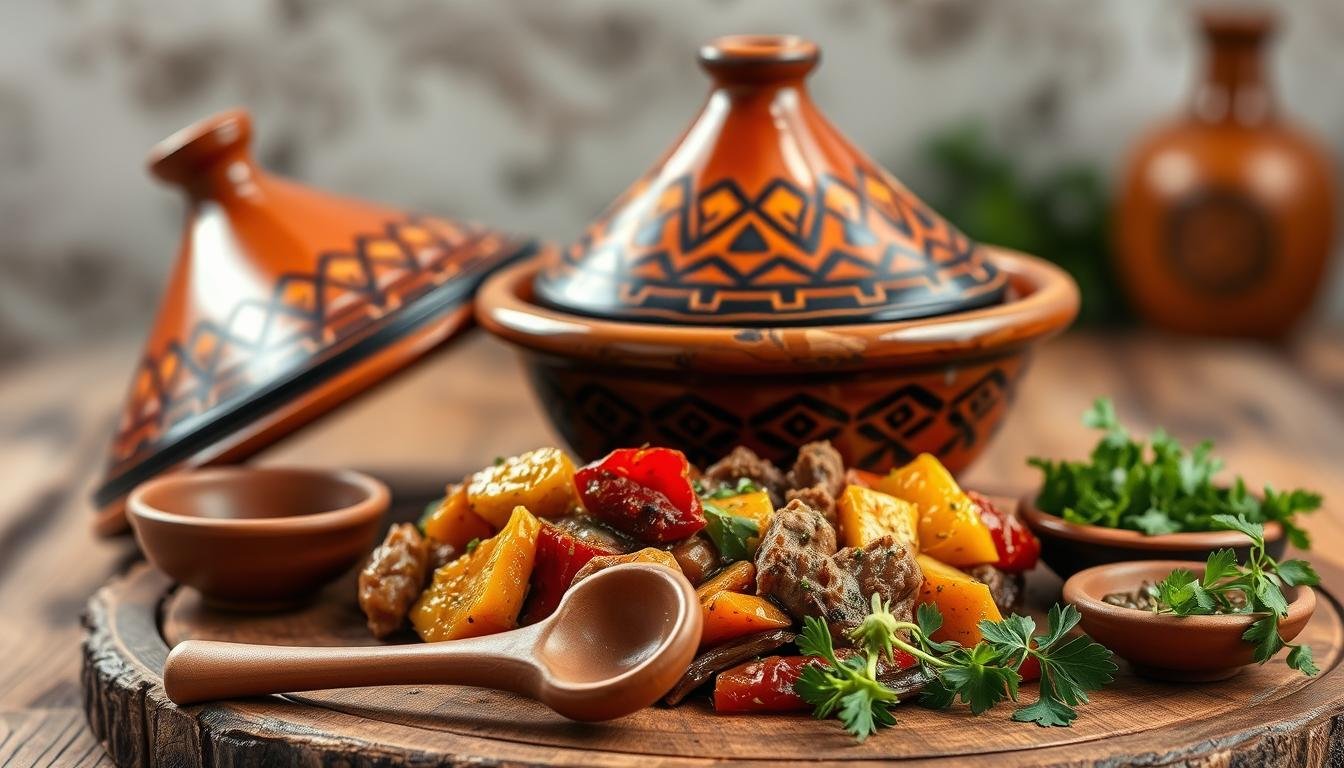Are you ready to dive into Moroccan cuisine and learn to make a traditional tagine? This iconic dish is a key part of Moroccan food. It’s known for its rich flavors and slow-cooked meats. You’ll learn the secrets of this beloved dish and how to make it at home.
Key Takeaways
- Tagine is a traditional Moroccan dish cooked in a unique conical-lidded pot.
- The recipe typically includes a combination of meats, vegetables, and spices, such as paprika, cumin, and coriander.
- Cooking time can vary, but a typical tagine recipe takes around 35-40 minutes to prepare and 2 hours to cook.
- The dish is often served with couscous, bread, or rice, and can be stored in the refrigerator for up to 4 days or frozen for 3 months.
- A traditional Moroccan food guide will often include tagine as a staple dish, showcasing the country’s rich culinary heritage.
- With the right ingredients and cooking techniques, you can create an authentic Moroccan cuisine experience at home.
- Tagine is a nutritious and flavorful dish, with a single serving providing approximately 442 calories and 32g of protein.
What is a Tagine?
A tagine is a traditional cooking vessel from North Africa. It’s commonly used in Moroccan cuisine for stews and slow-cooked meals. Trying a tagine is a must when exploring Moroccan food, offering a unique and flavorful experience. The word “tagine” comes from the Arabic for “frying-pan” or “saucepan,” with a history dating back to Harun al-Rashid’s time.
The tagine’s conical lid is key. It collects steam and returns liquid to the dish, making it rich and tender. This method is perfect for authentic Moroccan recipes like lamb with prunes or chicken with apricots. It uses little water, great for areas with water shortages.
Some key traits of a traditional tagine include:
- Earthenware construction
- Conical lid for steam collection
- Minimal water requirements
- Slow-cooking over low heat
When exploring Moroccan food, don’t miss out on trying a traditional tagine. It’s often served with bread and has a unique spice blend. For the best Moroccan dishes, try a classic tagine with lamb and prunes, or a vegetarian option with chickpeas and sweet potatoes.
Essential Ingredients for Tagine
Preparing a delicious tagine requires the right ingredients. Tagine is a key part of Moroccan street food. It’s known for its rich flavors, made with meats, vegetables, and spices.
The base of a great tagine is the meat, like chicken, beef, or lamb. It’s paired with onions, garlic, and ginger for depth and aroma. Preserved lemons add a tangy citrus flavor. Spices like cumin, coriander, and cinnamon add warmth and complexity.
Some popular ingredients in tagine include:
- 2 pounds of boneless chicken thighs
- 1 onion
- 2 cloves of garlic
- 1 tablespoon of ginger
- 1 teaspoon each of turmeric, cumin, cinnamon, and paprika
- 1 cup of chicken broth
- 1 cup of diced tomatoes
- 1 cup of pitted green olives
Vegetables like carrots, bell peppers, zucchini, and eggplant can also be added. They boost the dish’s flavor and nutrition. The secret to a great tagine is slow cooking. This lets the flavors mix and the meat become tender. With the right ingredients and cooking, you can make a delicious, authentic Moroccan tagine.
Choosing the Right Equipment
When cooking Moroccan cuisine, the right tools are key. The tagine pot is crucial for cooking tagine. It’s a must-have for Eating in Morocco and cooking Traditional dishes in Morocco. Look for a tagine that fits your needs, considering material, size, and lid type.
Tagines can be made of clay, cast iron, or ceramic. Each has its own pros and cons. Clay tagines cook stews slowly and evenly but are fragile. Cast iron tagines are durable but can be heavy and pricey.
Size matters too. Tagines range from small for one or two to large for families. Choose based on your serving size and dish type. Here are some common sizes:
- Individual (1-2 servings)
- Family-size (4-5 servings)
- Large (6-8 servings)
Finding the right tagine depends on your cooking style and preferences. Whether for one or many, there’s a perfect tagine for you. With the right equipment and traditional methods, you’ll make delicious Moroccan cuisine that wows everyone.
Preparing Your Ingredients
To make an authentic Moroccan dish, you need to prepare your ingredients well. When looking at Authentic Moroccan recipes, the secret to a tasty tagine is in the prep work. Start by chopping and marinating your proteins, like lamb or chicken, to soak up the spice flavors. For a Moroccan food guide, marinating is key to tender and flavorful meat.
Then, get your veggies ready, like onions, carrots, and garlic, which are staples in Best Moroccan dishes. These add sweetness and depth to your tagine. Make sure to chop them evenly for even cooking. Also, measuring your spices right is crucial for balancing the flavors. With the right spices, you’ll make a rich, aromatic tagine that captures Moroccan cuisine’s essence.
Here’s a quick list of what you’ll need:
- 2 pounds of lamb or chicken, cut into 1 ½ inch cubes
- 3 tablespoons of olive oil
- 2 teaspoons of paprika
- 1 teaspoon of ground cinnamon
- Salt and pepper, to taste

By following these steps and using the right ingredients, you’re on your way to a delicious Moroccan tagine. Don’t forget to check a reliable Moroccan food guide for more tips and techniques to make the perfect dish.
Cooking Techniques for Tagine
Cooking with a tagine requires some special techniques to get the flavors right. Moroccan dishes like tagine are famous for their rich tastes. To start, season the tagine before cooking to handle heat well.
The tagine is used for both cooking and serving in Moroccan cuisine. It’s best to use a diffuser on the stovetop to avoid damage. Cooking slowly helps create tender, flavorful meals, a key part of Moroccan food.
Here are some important tips for cooking with a tagine:
- Use a heat diffuser on electric stovetops to prevent direct contact with coils
- Avoid extreme temperature changes to prevent cracking
- Don’t add hot liquids to a cold tagine or vice versa
- Keep a simmer to get the perfect flavors and textures
For cooking times, poultry takes about 2 hours, while beef or lamb can take up to 4 hours. Remember, less water is needed in a tagine because of its shape. Following these tips will help you make delicious Moroccan dishes.
Vegan and Vegetarian Tagine Recipes
Vegan and vegetarian tagine recipes are a tasty way to explore Moroccan street food. These dishes are not only delicious but also offer a unique taste of Local delicacies in Morocco. The vegan tagine can be made with chickpeas, sweet potatoes, and a blend of spices.
A classic vegetable tagine is a popular choice. It’s made with a mix of vegetables like carrots, bell peppers, and onions. Cooked in a rich and flavorful broth, it’s both tasty and nutritious.
Other variations include a chickpea and sweet potato tagine. This dish is made with chickpeas, sweet potatoes, and spices. It’s delicious and offers a unique taste of Moroccan cuisine. Serve it with couscous or pita bread, and garnish with fresh cilantro and green olives.
Popular Moroccan Tagine Recipes
Moroccan cuisine is famous for its rich flavors, and tagine is a top dish. There are many tagine recipes, making it hard to pick one. We’ll look at popular ones like chicken with apricots, lamb with prunes, and fish with tomatoes.
These Authentic Moroccan recipes showcase the Best Moroccan dishes. They’re perfect for anyone wanting to taste Morocco. These recipes are simple and need just a few ingredients. For a full Moroccan food guide, try different tagines like chicken, lamb, and fish.
Some favorite tagine recipes include:
- Chicken tagine with apricots and ginger
- Lamb tagine with prunes and cinnamon
- Fish tagine with tomatoes and coriander
These dishes are not just tasty but also let you dive into Morocco’s culture and history. Moroccan food is a mix of spices and ingredients that you must try.
Tips for Perfect Tagine
Preparing a delicious tagine requires attention to detail. You need to get the consistency right, balance the flavors, and adjust the cooking time. In Moroccan cuisine, tagine is a key dish. Mastering it can make your Eating in Morocco experience better. Traditionally, tagines are cooked in heavy earthenware pots, which boosts the flavors.
Getting the consistency right is key. Use the right amount of liquid, as a tagine pot uses less than a casserole. For example, a recipe might need 175ml of water. This amount is enough to flavor the dish without making it too watery. Balancing flavors is also important. Use spices like cinnamon, ginger, and saffron, which are common in Traditional dishes in Morocco.
Adjusting cooking time is crucial. It depends on the ingredients and your taste. For chicken tagine, simmer it gently for about 45 minutes. Here are more tips for the perfect tagine:
- Use high-quality ingredients, such as fresh vegetables and meats.
- Don’t overcook the dish, as this can result in dry, flavorless meat.
- Experiment with different spices and flavor combinations to find your favorite.

By following these tips and practicing, you’ll make delicious, authentic Moroccan cuisine. Whether you’re Eating in Morocco or cooking at home, mastering tagine will elevate your cooking.
Serving Your Tagine
Serving your tagine is as important as the dish itself. In Morocco, meals are a time to bond with family and friends. To make it authentic, serve the tagine in the traditional way, from the cooking vessel. Add side dishes like couscous or bread.
Trying Moroccan street food is a must when visiting. It offers a variety of flavors. When serving tagine, have different side dishes to match its rich flavors. Moroccan salads are a great choice, served around the tagine for everyone to try.
For a real experience, serve the tagine with khobz (Moroccan bread). It’s great for soaking up the tagine’s sauce. Moroccan tagines are made from earthenware clay, adding to the authentic feel of the meal.
These dishes make for a memorable meal. They let your guests enjoy all the flavors Moroccan cuisine has to offer, including what to eat in Morocco.
Common Mistakes to Avoid
When cooking tagine, it’s key to avoid common mistakes. These can ruin the flavor and texture of the dish. It’s important to stick to Authentic Moroccan recipes and follow a good Moroccan food guide. This way, your tagine will be delicious and true to its roots.
Some mistakes to steer clear of include overcooking, using too many spices, and not layering ingredients right. Overcooking can make the meat dry and tough. Too many spices can overwhelm the dish’s other flavors. And not layering properly can cause some ingredients to cook unevenly.
To sidestep these errors, use a reliable recipe and top-notch ingredients. The Best Moroccan dishes often use simple, fresh ingredients. Success comes from careful preparation and slow, patient cooking. This way, you can make a tasty and authentic Moroccan dish.
By avoiding these mistakes and sticking to traditional methods, you can make a memorable tagine. With practice and patience, you’ll master Authentic Moroccan recipes. You’ll enjoy the rich flavors and aromas of Moroccan cuisine.
Storing and Reheating Tagine
Storing and reheating tagine right is key to keep its flavors and textures. In Moroccan cuisine, tagine is a big deal. It’s often enjoyed in Morocco, bringing out rich flavors. To keep your tagine fresh, store it in an airtight container in the fridge for 3-4 days. Or, freeze it for later.
When reheating tagine, you have a few options. You can reheat it on the stovetop, in the microwave, or in the oven. For stovetop reheating, add a bit of water or stock to keep it moist. This method helps keep the dish’s moisture and flavor, just like slow cooking in a traditional tagine pot.
Here are some tips for storing and reheating tagine:
- Use airtight containers to prevent moisture and other flavors from affecting the dish.
- Label and date the containers so you can easily keep track of how long they’ve been stored.
- Reheat the tagine gently to prevent burning or drying out the ingredients.
By following these tips, you can enjoy your tagine for a longer time. This way, you keep its rich flavors and textures. It’s a big part of traditional Moroccan cuisine and eating in Morocco.
Conclusion: Enjoying Your Tagine Experience
Cooking a traditional Moroccan tagine is more than just food. It’s a journey into the heart of Moroccan culture. You’ll not only enjoy the flavors but also learn to love the rich history behind it.
Once you learn to make tagine, share it with your loved ones. It’s a great way to bring people together. Everyone will love the mix of spices and the tender meat.
Keep exploring new tagine recipes and flavors. There’s always something new to try. Each dish will show you more of the amazing Moroccan cuisine. Bon appétit, and enjoy your culinary adventures!




Comment (0)